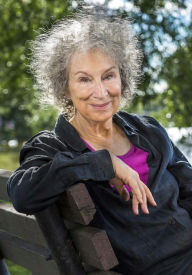What is the role of the writer? Prophet? High Priest of Art? Court Jester? Or witness to the real world? Looking back on her own childhood and the development of her writing career, Margaret Atwood examines the metaphors which writers of fiction and poetry have used to explain -- or excuse! -- their activities, looking at what costumes they have seen fit to assume, what roles they have chosen to play. In her final chapter she takes up the challenge of the book's title: if a writer is to be seen as 'gifted', who is doing the giving and what are the terms of the gift?
Margaret Atwood's wide and eclectic reference to other writers, living and dead, is balanced by anecdotes from her own experiences as a writer, both in Canada and on the international scene. The lightness of her touch is underlined by a seriousness about the purpose and the pleasures of writing, and by a deep familiarity with the myths and traditions of western literature.
bn.com
In the spring of 2000, novelist and poet Margaret Atwood delivered the Empson Lectures at Cambridge University. Now, Cambridge University Press has gathered Atwood’s six memorable lectures into a delectable book. In Negotiating with the Dead, the Canadian-born author moves brightly between personal stories, literary judgments, and a sage inquiry into the role of the writer. Long a master and advocate of mischief, Atwood explains how the crafty disruption of prose transforms us all. Her insights make every reader a co-conspirator.
Library Journal
This book grew out of the series of Empsom lectures that prize-winning novelist Atwood gave at the University of Cambridge in 2000. In it, she addresses a number of fundamental questions: not how to write but the basic position of the writer, why a writer writes, "and for whom? And what is this writing anyway?" Wearing her learning lightly, Atwood allows her wit to shine on almost every page. She probes her life and work along with those of many other writers and brings in myths, fairy tales, movies whatever feeds her themes. Following an initial autobiographical chapter, Atwood addresses major issues: the duplicity evidently inherent in writing; the problems of art vs. money; the problems of art vs. social relevance; the nature of the triangular relationship of writer, reader, and book; and, in the final title chapter, the provocative idea that "all writing of the narrative kind, and perhaps all writing, is motivated, deep down, by a fear of and a fascination with mortality by a desire to make the risky trip to the Underworld, and to bring something or someone back from the dead." Atwood is not looking to provide answers or solutions but to explore the parameters of some interesting questions. The result is engaging food for thought for all who care about writers and writing. Recommended for academic and large public libraries. Mary Paumier Jones, Westminster P.L., CO Copyright 2002 Cahners Business Information.
From the Publisher
[Atwood] teases, probes, tickles, punches and enlightens.” — The Globe and Mail“This interesting and compelling book is as wise as it is charming and it is very charming indeed.” — The Washington Post Book World
“Atwood’s style glistens with sharp details and sly wit. The range of reference is deliciously eclectic.” — Quill & Quire
“There is a steely quality to Ms. Atwood’s writing that’s a bit scary but also enlightening; no one gets away with anything.” — Wall Street Journal
“Atwood’s riffs on writing not only will delight readers who are fans . . . but also may serve to cheer fledgling writers.” — Los Angeles Times
“Atwood allows her wit to shine on almost every page. . . . The result is engaging food for thought.” — Library Journal
Read More












